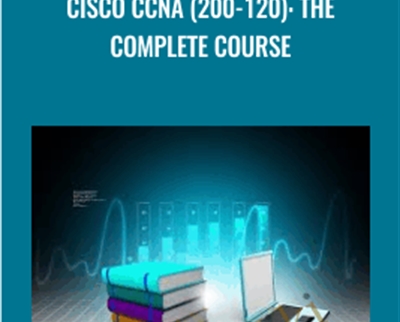$40.00 Original price was: $40.00.$16.00Current price is: $16.00.
This course will cover everything you need to prepare for the 200-120 certification exam!
 Purchase this course you will earn 16 Points worth of $1.60
Purchase this course you will earn 16 Points worth of $1.60This course is over 24+ hours in length and will cover all the needed subjects to be successful in passing your CCNA 200-120 exam; also the knowledge and practice labs acquired in this course will be transferable to real world use as a Cisco professional.
"This course is complemented by my newest course: Cisco CCNA (200-120) Labs: Gateway to Success! which covers all the labs needed to further give the students the practice to prepare for configurations and simulations that will be encountered in the CCNA certification exam. I have also created a free Dropbox on my website that has all the material, labs and other resources to compliment my CCNA courses."
This course will give students an in-depth understanding of networking, using routers and switches and their various configurations and connections. Students will learn how to configure; default, static and dynamic routing. Students will comprehend how to manipulate each of the routing protocols attributes to meet the requirements of the network.
This course will also prepare the student in Layer 2 technology and its various configurations, such as; VLAN’s, VTP, STP, PortFast, EtherChannel, Port-Security, Inter-VLAN communication & Trunking.
Students will also acquire the knowledge needed to secure their routers through the use of Access-list, configuring the different types of NAT & will be able to manage the router’s components.
Students will also be able to thoroughly grasp the concepts of both Internet Protocols; IPv4 & IPv6.
Wide Area Network Protocols will also be covered; HDLC, PPP & Frame Relay. The student will also learn how to create redundancy in their networks through the use of Redundancy Protocols such as HSRP which is just as important. Also, within the WAN, the student will also learn how to create VPN’s and GRE Tunnels.
This is a full comprehensive course that will take you from A-Z in your quest for the CCNA (200-120).
Course Curriculum
Welcome to the most COMPLETE CCNA (200-120) Course…get ready to be amazed!
- Your First Journey into the Cisco World (2:02)
- Why acquire a CCNA certification? (2:58)
- How would you get CCNA Certified? (4:13)
- Which CCNA test should I take? (6:33)
- What does the course consist of? (6:23)
The Packet tracer Simulator
- Navigating the Packet tracer tool (29:59)
- How to create a simple topology (6:46)
- Configuring a router (3:21)
- Configuring a switch (6:13)
- Configuring a PC (6:24)
- configuring a server (5:35)
The Basics of Networking
- Understanding the Need for Networking (4:42)
- Communication at its lowest layer (10:13)
- Internetworking Devices used on a network (20:35)
- The importance of segmentation (10:35)
The OSI Model
- A brief history of the OSI model (2:53)
- The layers of the OSI model (6:46)
- The 3 Upper Layers of the OSI (8:06)
- The 4 Lower Layers of the OSI (6:59)
- The process of Encapsulation (2:43)
Binary to Hex and Decimal conversion
- The tables we use when converting (4:19)
- Converting a Hex number to binary/decimal (10:25)
- Converting a Decimal to binary/hex (6:26)
- Why do we need to know Hexadecimal numbers? (2:41)
Cisco three Layer Model
- Core Layer (4:32)
- Distribution Layer (4:11)
- Access Layer (5:57)
TCP/IP model
- A brief history of the model (4:12)
- The layers of the model & how they map over to the OSI (4:45)
Ethernet Networks
- Definition of Ethernet Networks (7:10)
- The access method of ethernet (CSMA/CD) (10:27)
- What cabling standards to we use? (12:05)
IPV4 addresses
- What is an IPv4 address & Its format
- Classes of Addresses and their ranges (16:03)
Private IP address range
- Definition of Private addressing
- Private Class A,B, C address range (14:47)
IPv6 Addressing
- Why do we need IPv6
- IPv6 addressing and Expressions
- IPv6 address types (10:05)
- The Auto-configuration feature
- ICMPv6 (5:26)
Transition Mechanisms
- Dual Stack, 6to4 tunneling and NATPT (13:30)
How to subnet in IPv4
- The subnet Mask
- Diagram used to subnet & Using the diagram…PLEASE NOTE: 2046 should be 2048
- Class-full subnetting (9:36)
- Class-less subnetting
- Route summarization
- Wildcard masking
How to subnet in IPv6
- Do we need to subnet In IPv6? (3:36)
- How to setup the diagram for subnetting. (4:58)
- Counting for subnets and finding increment value (4:50)
- Laying out the subnets with the new network prefix (4:42)
Inside a Cisco router
- How to connect to a router
- Components we need to know about
- Boot Sequence of a Cisco routerNavigation of the IOS
Administrative configurations
- House Keeping configurations (30:28)
- interface configurations (16:57)
- Telnet and SSH into routers
- show commands (8:07)
DHCP and Name resolution on Cisco routers
- configuring DHCP
- Configuring DHCP Relay Agent (19:52)
- Configuring static host tables (9:32)
Using the Cisco Discovery Protocol
- using the CDP command
The Cisco register
- Manipulating the register within the router
- Accessing & manipulating the register within ROMMON
Routing Process
- How does IP routing occur
- what type of routing should I use?
- what are default routes & where do you configure them?
- configuring static routes (10:59)
Dynamic Routing
- An overview of the three Dynamic routing protocols (19:47)
- RIPv2 & RIPng configurations
- EIGRP & EIGRPv6 configurations
- EIGRP Bandwidth Lab (17:49)
OSPF Details
- OSPF Terminology (21:18)
- Point-to-Point ospf
- Multi-access ospf
- OSPF multiple area details
Switching at Layer 2
- Purpose of Using Switches & Specific functions at Layer2 (17:37)
- Navigation on a switch and show commands (13:59)
- Administration configurations (8:35)
The basics of VLANs
- What are vlans and the importance of using vlans in our network?
- How to create and assign a vlan /Trunking appropriate ports
The Spanning-tree Protocol
- what is STP used for (6:15)
- How does the STP election process work
- How to manipulate the election process
- Turning STP off and Guarding against BPDUs on ports not using STP
The Virtual Trunking Protocol
- What is the purpose of this protocol (12:36)
- Commands and Configurations of the VTP protocol (14:23)
- Turning on and adjusting port-security on your switch (7:08)
Inter-vlan routing
- What is the purpose of intervlan routing (11:55)
- How to configure intervlan routing Part1 (34:07)
- How to configure intervlan routing Part2 (22:35)
Secure your Enterprise using ACL's
- what is an ACL's and its rules (12:56)
- Standard ACL's (20:23)
- Extended ACL's (25:49)
Network Address Translations
- 3 Types of NAT (7:30)
- How does NAT work (6:20)
- Configure NAT Overload and Dynamic (7:52)
- Actual Configuration of NAT Overload (7:28)
- Pitfalls to look for on your test (5:43)
Wide Area Networks
- What exactly is a WAN (7:13)
- What are the connection types (11:21)
Frame-Relay Packet switched techonology
- Understanding the CIR and Burst Rate (12:39)
- What is a DLCI and who assigns it (9:26)
- configuring Frame-relay (24:54)
- show commands for frame-relay (9:18)
PPP Dedicated leased connection type
- Open Standard WAN protocol (7:38)
- Configuring PPP and Verifying PPP (15:57)
IP services
- Redundancy protocols overview (12:36)
- HSRP Details and configuration (43:45)
- VRRP and GLBP (9:38)
Managing Devices
- SNMP and its Configuration (21:53)
- SYSLOG and its Configuration (11:43)
- NETFLOW and its Configuration (8:34)
Summary of the Course
- Course Summary (6:25)
- CCNA 200-120 Final Exam
New Section Explaining EtherChannel
- Introduction to EtherChannel (0:44)
- What is EtherChannel (3:49)
- EtherChannel Lab (12:45)
- Summary of Section (2:29)
Get Cisco CCNA (200-120): The Complete Course – Lazaro Diaz, Only Price $20
Tag: Cisco CCNA (200-120): The Complete Course – Lazaro Diaz Review. Cisco CCNA (200-120): The Complete Course – Lazaro Diaz download. Cisco CCNA (200-120): The Complete Course – Lazaro Diaz discount.
Only logged in customers who have purchased this product may leave a review.
Related products
= 85 Points
= 125 Points
Uncategorized
= 95 Points
= 84 Points
Uncategorized
= 35 Points
Uncategorized
Optimizing Compliance and Maximizing Revenue for Ophthalmology and Optometry – Jeffrey P. Restuccio
= 85 Points
Uncategorized
= 35 Points
Uncategorized
Managing Geriatric Behaviors: Wandering, Aggression, Malnutrition and More – Steven Atkinson
= 35 Points





Reviews
There are no reviews yet.